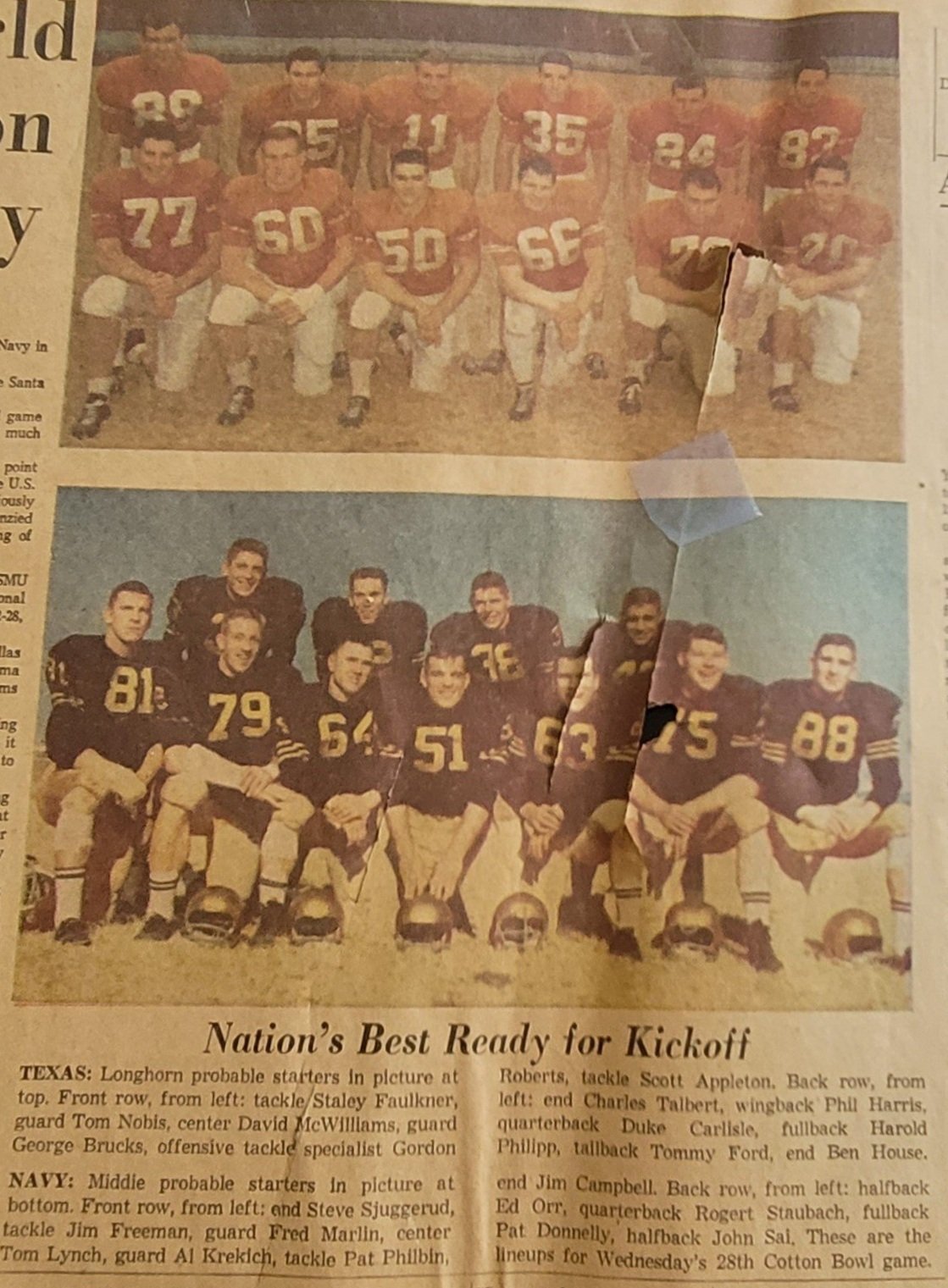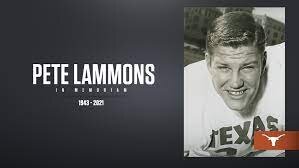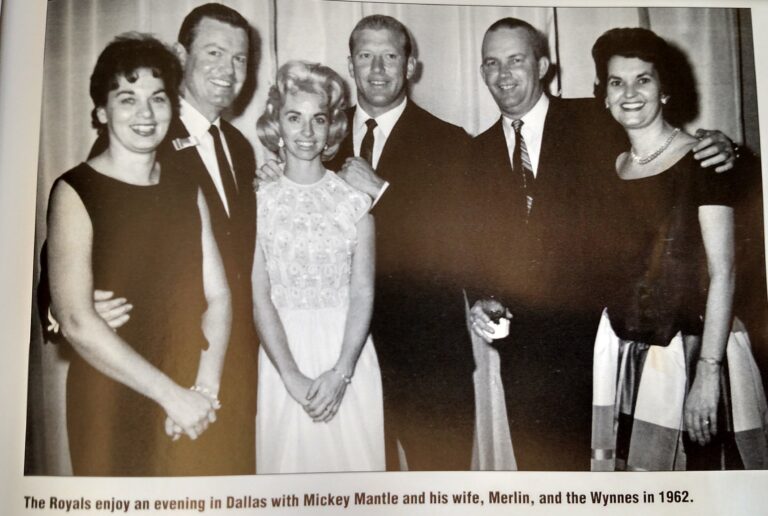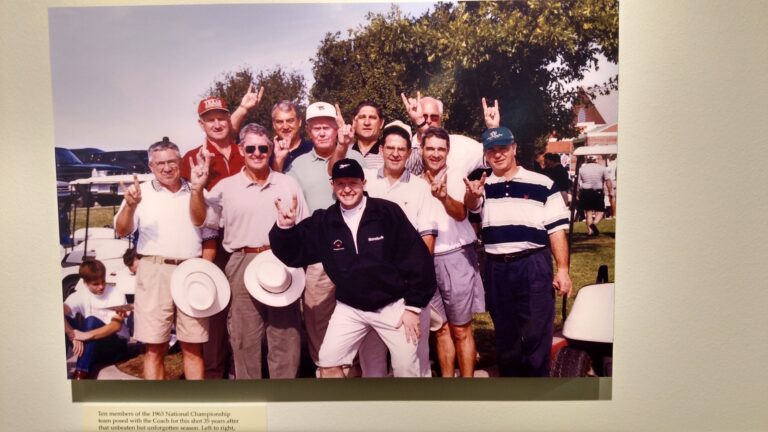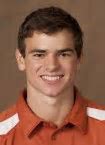1961-1964- Just missed earning three national championships- Coach Royal football
Jones Ramsey said, “ Darrell had charisma. A disease you can’t get rid of.” “Darrell was a sweet Bear Bryant,” However , Royal’s players never saw that side of him.
Please go to this website’s “credit” section to view books you can purchase from many fine bookstores about Texas Longhorn Sports or visit the official University of Texas Longhorn website at Texassports.com.
Everything Royal had implemented since 1957 – the facility improvements, the torturous training regimen, the aggressive recruiting, the scheme changes, were about to pay off.
From 1961- 1964, Texas’s record was 40-1- 3, with one national championship, and With a little luck, it could have been three. From 1961-1983 the Longhorns had nine one-loss seasons.
1961 – 10—1 DKR recruits Speed and is one cockroach away from a national championship.
The 1961 team featured the first all-Royal team. Royal recruited, Royal coached, and Royal-indoctrinated.
This was the year of Longhorn running backs with speed and quickness. The flip-flop offense was perfect for Ray Poage, Jack Collins, James Saxton, Jerry Cook, and Tommy Ford.
“1961: At the Texas vs. Cal football game, a UT Austin cheerleader alumnus hired San Francisco night club girls (from Bimbo’s Club – still there!) as substitute UT cheerleaders. Texas won 28‑3.”
https://twitter.com/JimNicar/status/1452681931850719245
The 1961 team, under the leadership of quarterback Mike Cotten, is a legitimate contender for the best DKR team. The TCU cockroaches destroyed a chance for a national championship in 1961.
DKR changes from a Split T formation because that offense failed to produce touchdowns in three games in 1960. Royal said, “We got to have something that will get us 20 yards every now and then.”
The flip-flop offense did the job! It was used to win 46 games over the next five years.
In the flip-flop, the same guard, tackle, and end line up on the right side for wing right and on the left side for wing left, a device that is being copied because it simplifies blocking assignments.
This is the first year a Royal-led team reached #1 in both the AP and United Press polls.
Final Ranking 3rd Nationally. The Flip-Flop Offense Sets Records and The Longhorn defense received notoriety as the “Tango” Defense (1,2,3 Punt).
The biggest upset in the history of Longhorn football cost the Horns a national championship.
But beating Texas when they were undefeated was not new history for Texas and TCU. It had occurred on 4 other occasions.
The Cockroaches
Texas had a botched field goal, a fumble, busted plays, the failure to hit a wide-open receiver, the inability to punch it in three times inside the five, twice inside the 30.
TCU rejects Texas at the goal line with a 4th and 1, and another time with 4th and 3, and Texas has two blocked field goals from inside the 25 to lose the game. Saxton was knocked out of the game with a concussion in the first half but returned in the second half only to get knocked silly and fumble the ball.
After losing to TCU in 1961, DKR says, “They (TCU) are like a cockroach. It isn’t what he eats or totes off, but what he falls into and messes up.” Royal says that losing to TCU was one of the worse losses of his football career. David McWilliams still believes that the 1961 team was the most talented team during his years at Texas.
61 was one of my all time favorites. Jimmy Saxton. Jack Collins, best Texas blocking back ever ?? When David McWilliams (he was good friends with one of my older cousins) came to Tulsa to talk to our group 10 or 15 years ago, he said the guys who played on 61,62,63 teams, they all thought 61 team was the best. I’ll NEVER forget sitting in the north end zone, looking at the scoreboard, TCU 6. Texas 0. I thought “This is not right !!” The whole stadium was stunned. We all walked out in silence. Richard Seifert
Saxton holds the Texas season rushing average record of 7.9 yards per carry.
Royal said when James came to Texas, he was a “rural runner” because he covered the whole countryside. Longhorns knew to keep blocking because he would come back around. After a while, Royal convinced Saxton to quit dancing, dipping and running side-to-side and just head upfield. James led the team in interceptions, rushing, receiving, and all-purpose yards.
November 24th, 1961, Texas is ranked Number 1 for the first time in school history.
Dave Campbell of the Waco News-Tribune said Coach Royal “has the great ability to adapt to his material.” The flip flop was implemented to use James Saxton’s new more disciplined running ability. Choosing to spend more time running North and South instead of East and West.
Royal said Saxton was a darting hummingbird. James pulled us out of so many games. Look at the Oklahoma game of 1961 and you’d think his mother put it (the game film) together. His teammates knew never to give up on their blocks because there was a chance he might zig-zag his way back to you.
James Saxton is MVP on Texas team.
The new offense exceeds all expectations, and the 1961 team gives Coach Royal his first bowl victory at Texas.
In the Cotton Bowl, Texas intercepted 5 Ole Miss. passes—Coach Royal’s 4th bowl appearance in 5 years, but his first win in postseason play. Ray Poage was the leading rusher in the game. Bob Moses was an outstanding Defensive lineman, and Mike Cotten won the Outstanding Back honor.
The Cotton Bowl game was the best match of all the bowl games because both Ole Miss and Texas had been ranked #1 at some point during the season.
It was Coach Royal’s 4th bowl appearance in 5 years but his first win in postseason play. In addition, it was the Longhorn’s first bowl win since 1953!
Texas’s share of the Cotton Bowl revenue was 177,175.99.
Texas intercepted 5 Ole Miss. passes. Jerry Cook has three interceptions. Mike Cotten is the hero of the Cotton Bowl game, and Royal is named “Coach of the Year.”
Saxon and Talbert make the All-American team, with Poage, Cotten, and Moses making the All-Southwest Conference team.
Royal was named Coach of the Year by the Football Writers Association of America, and the Horns celebrated their great year by organizing the first football banquet.
1962- 9-1-1 Coach DKR- Defense leads when the Flip-Flop flops.
1962- Student population was 23,000.
Texas won their 4th SWC championship in 5 seasons and logged the University’s first undefeated season in 39 years. .`
Royal knew that all but one in the speedy backfield of 1961 graduated and were irreplaceable, so 1962 was the year of the Longhorn defense. Royal did his homework and knew that over his last five years at Texas, the Horns made 21 successful goal-line stands, nine coming in games where an additional touchdown would have meant defeat. He would need that kind of defensive performance in 1962 to win, and it happened. Texas held five teams to no touchdowns in 1962.
Royal’s conservative play was problematic in 1962. Fans and sports writers criticized Royal’s coaching style and the team’s performance. Lou Maysel said that Royal playing for a tie was a losing strategy. He scolded Royal in print for “playing for the break instead of trying to make our own breaks.” Dan Cook for the San Antonio Express said, “They may not pass, And they may not thrill you. But brother, they block and tackle you find, and in the long run, they usually beat you.”
Pat Culpepper disagreed with Lou, reminding Longhorn fans the Horns were “respected by all, criticized by some, defeated by none.” A sportswriter said Texas was “the most criticized undefeated team in history.” “Royal said, “I hope it will continue to make news when we lose a game rather than when we win one.”
Royal started Genung on offense, employing Carlisle as a defensive safety and keeping Wade’s passing arm in reserve to use when needed.
“Tony Crosby kicks a field goal on 5th down that beats OU. In the book Oklahoma vs. Texas by Robert Heard, the author says, “Although it is a fleeting glimpse, it appears the man holding the down marker started to turn the “2” over to show the “3” when something distracted him, and he let the “2” drop back in place.
Captains Pat Culpepper and Perry McWilliams
1962 was a prelude to greatness. As TCU had done to ruin a perfect season, Rice did in 1962. Even if the Horns had won the Rice game after the Cotton Bowl loss to LSU, it is evident that the Horns were still not ready for prime time. LSU dominated the Horns with their defense, and the only Horn offense was a 30-yard field goal attempt that was wide. Even with the loss, Johnny Treadwell is the outstanding lineman of the Cotton Bowl.
Johnny Treadwell is the MVP on the Texas team.
Below Is A 1962 Letter To The Texas Ex-Students Association
17 Sophomore Lettermen Return For the 1962 Season
Final ranking 4th nationally
Knox Nunnally 1962 HOH
Coach Royal changed the Texas uniforms’ color from bright orange to Clyde Littlefield-era Burnt Orange and removed the helmet stripe. The fan base was not happy with the color change, and the issue remained unresolved until a UT committee decided in 1967 to officially make burnt orange the color for Texas.
The defense only allowed eight touchdowns all season. As in 1969, the Arkansas game decides the season. Texas wins 7-3.
Royal gets a raise to $20,000 a year and a promotion to Athletic Director.
Author Lou Maysel says that Royal decides to focus on defense instead of offense. Reasoning?? Because “During Royal’s first five years, there were 21 successful goal-line stands, nine of them coming in games where an additional touchdown would have meant defeat.”
The decision is made to use Sophomore Ernie Koy as wing-back.
Ernie Koy places 2nd in the SWC in the shot put with a toss of 50 feet.
Reggie Grob dies of heat Exhaustion at practice. One year later, all Universities are offering more liquids to athletes during workouts and games.
After Reggie’s death Jones Ramsey (Sports Information Director) says that Coach Royal collapses and cries “in the huge arms of Defensive line Coach Charley Shria.”
The “hit” 1962- Texas 7 Arkansas 3
#1 Texas 7, #7 Arkansas 3
Broyles was worried about the Texas defense and the talents of Ernie Koy. Ernie could kick the ball quickly with height and distance, making it impossible to return. Koy was an essential part of Royals strategy to win games by converting excellent field position into points.
Pat Culpepper and Treadwell – The Hit in 1962 – Texas 7 Arkansas 3. Joe Dixon recovered the fumble in the end zone.
Going into the game, both teams are undefeated. Arkansas leads 3-0 going into the 3rd quarter. This was Royal’s first time to Coach to a sell-out crowd. Arkansas drives to the Longhorn 5 yard line. It was then that the Hogs mounted a drive that took them to the Texas 5-yard line. With Arkansas first-and-goal, UT linebacker Johnny Treadwell told his teammates, “All right, we’ve got them right where we want them. They have run out of room. They can’t throw a long pass. They’ve got to come right at us.” Two plays later, Arkansas fullback Danny Brabham rammed into the line from the three and was met by Treadwell and Pat Culpepper. Culpepper’s helmet popped the football loose from Brabham, and Texas recovered in the end zone for a touchback. The Longhorns turned the ball back over but again stopped the Hogs, this time on fourth-and-one at the Texas 12-yard line. After that stop, Duke Carlisle leads the team on a 20-play, 90-yard drive. Before this’ “Big Drive,” the Longhorns had just one first down in the second half.
With 36 seconds left to play, The Longhorn offensive line opens a hole Tommy Ford squeezes thru for a 3-yard touchdown. The 65,000 fans at Memorial stadium went wild, screaming and yelling. Cannons exploded, cushions went flying, the Longhorn band blasted out notes of victory, and fans sitting in their cars started honking in celebration.
Roy Jones shares a story about George Sauer:
Coach Royal was good about taking even red-shirts to the Cotton Bowl (we went all three of my class' years 1962-64). The year George Sauer red-shirted he and some others who weren't going to play were up after curfew, burning off some alcohol by seeing who could knock a heavy wooden chair farther with a "forearm shiver." George won the contest, nearly knocking the chair through the windo but broke the radial bone in two places. I don't know how he explained that to Coach Royal and Frank Medina.
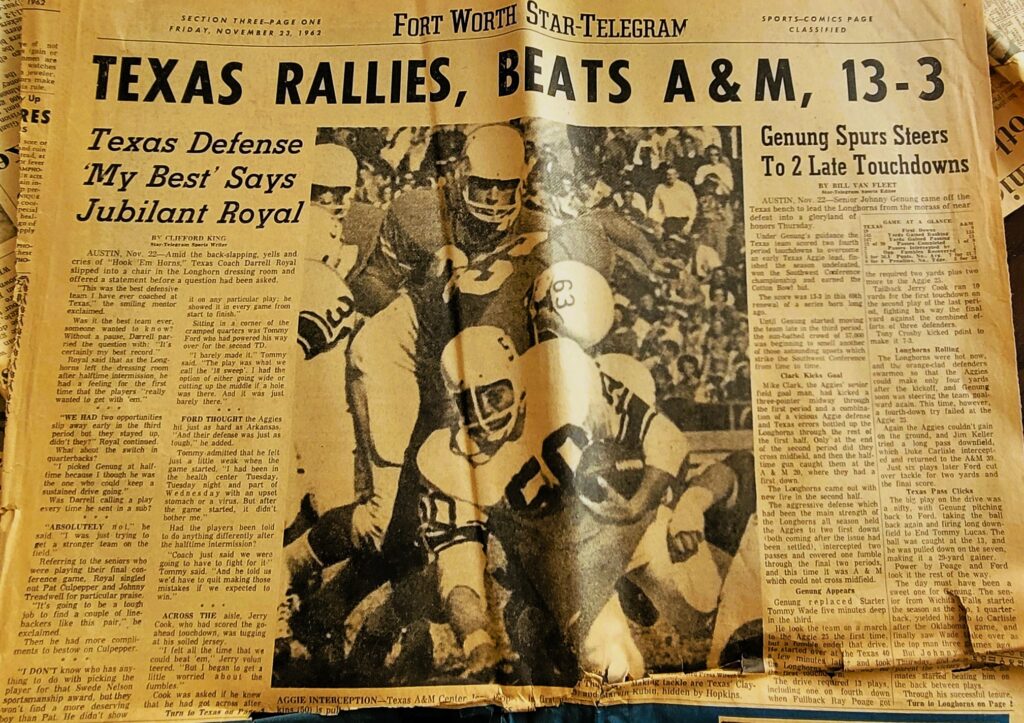

Appleton, Treadwell, Culpepper, and Ford make the All-SWC team. Treadwell was an All-American.

The Longhorn connection to San Antonio Jefferson High School
Back to Front Tommy Nobis, Anthony King, Phil Harris, Hix Green – All from San Antonio Jefferson
J. T. King, the Raiders’ head coach, knew he was outmanned, so he devised some trickery at the very beginning of the evening. He won the coin toss and elected to receive. All seemed normal until the return specialist kicked the ball back to get field position. Fortunately, it didn’t work, and the Longhorns won 34-0 without lights on the west side. The lights were not crucial for a team that primarily runs the ball.
1963 11-0 DKr National Champions
DKR vowed never to be caught in a three-quarterback quandary like he was in 1962. So, Royal decided quickly that Duke would be his quarterback in 1963.
Texas was the only team in 1963 that did not lose a game.
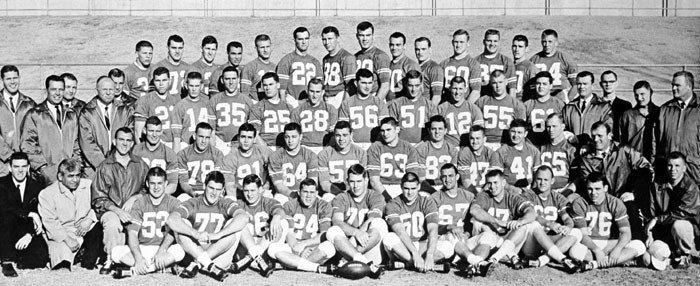
The foot that Made a difference
In 1963, the Longhorns beat the #1 Sooners and the #2 Razorbacks.
In the early ’60s, the quarterback, not the coach, called most of the plays because of the limited substitution rules and rules about coaches calling in a play.
Four SWC games were won by a touchdown or less. In several games, Tony’s foot was the difference between competing for the national championship and a mediocre season.
Author Kern Tips says, “In addition to a sound, solid, determined, panic-proof, and expertly coached and captained team, you still need the kiss of the charmed life to bring it off.” 1963 was the year luck followed the team that tried the hardest.
Royal’s wit gets him in trouble again. Royal said, “Put me in a room with 50 people and tell me half went to Texas. I’ll sort ‘em out. The guy with the blue serge suit with his green socks rolled down didn’t go to Texas .”
The Baylor game pitted Baylor coach John Bridger’s passing offense and the dreaded green socks against Royal’s conservative” percentage football”
#1 Texas 7, Baylor 0
Jones Ramsey said this game attracted more media requests for tickets than the 1969 Big Shoot-out.
Baylor was at the Texas 19-yard line with 29 seconds in the game when the great quarterback Don Truill and receiver Lawrence Elkins appeared to connect for a touchdown. Only to have Duke appear from nowhere to intercept the ball.
John Robert Pharr A Fans perspective of the Baylor game.
I was a junior at University High School in Waco in 1963. We lived about a half mile from Baylor Stadium, so my Dad and I had seen many a Baylor (and Texas every other year) game. Don Trull and Lawrence Elkins were All Americans and they were very hard to defend against.
My Dad and I went to college station to see Baylor play aggy, and Baylor mud stomped them pretty good.
The upcoming Baylor Texas game was the most anticipated game that Waco had experienced in many years. There was a lot of buzz around town
The week after the game was played, our coaches were able to secure a copy of the game film from the Baylor Athletic Department. We watched as a team, and it was a superior teaching tool for us. We went over and over that film to see how football was really played
Two years later I was enrolled at UT Austin, and I’m fortunate to have a degree from there. I will say that Coach Royal and Texas football had a huge influence on me. I wanted to be among the best, and I was never disappointed in the decision I made.
Now, 60 years later, I vividly remember that game, those two teams, and that season. 1963 was the best of times, and in a fleeting moment, the worst of times.
In his book Longhorn & Tall Tales, Duke says Royal was confused and irritated that many Texas fans thought his teams were dull and uninspiring.
The coach said, “At first, our fans only wanted to win. Now they not only want to win, but they also want to win big and flamboyantly.”
The 1963 Team Holds The Season Record For Fewest Yards Allowed On Opponents Punt Returns (59 Total Yards).
1963 Tommy Wade, King, McWilliams, Sandy Sands
1963 is the first perfect record for the Horns since 1920. The key to the victories was depth when there were injuries, second efforts, senior leadership, and excellent coaching staff.
The SWC set an attendance record of 1,505,004 sold tickets.
UT Longhorns 1963 Championship Season (texasarchive.org)
Joe Don Looney
A new breed of football players at the college level started surfacing in the 1960s. A rebellious group that questioned authority rejected the Vietnam War, abhorred racial discrimination, and rejected dress codes. These players wanted to have a good time. Joe Don Looney was an extreme example. His body was always present, but his eyes had a faraway look.
O.U.’s Joe Don Looney was respected as a great running back. Many football fans and players were still repulsed by his lack of respect, arrogant attitude, and condescending remarks about the Longhorns. Bobby Gamblin was so upset with some of Joe Don’s comments that he hollered at Looney during the pre-game of the 1963 Texas O.U. game, ” Hey Looney, Get Off The Field, You Creep. You’re Killin,” The Grass.” Texas won the game, and the next week, O.U. released Joe Don Looney from the team.
Looney’s full story is at the link below.
https://www.texaslsn.org/joe-don-looney-and-texas
TOP OF THE CHARTS
Texas O.U. game and Texas-Baylor game.
Texas is #2 and OU #1 when the two teams meet in October. Carlisle throws for a touchdown, and Texas easily wins 28-7. Days later, Carlisle graces the cover of Sports Illustrated. “Seemingly nerveless” is how the magazine described Carlisle. ” A cool operator,” he is called.
The win against the 6 -1 Baylor team and the great Don Trull and Lawrence Elkins was one of the only times Coach Royal trashed talked. DKR said about Baylor, ” You know the guy in the blue serge suit with his green socks rolled down didn’t go to Texas. He regretted that comment and never again publicly disparaged another team or their fans. Royal said, ” It was a comment not made in malice, but the poor choice of wording was open to misinterpretation, and it was!” In protest to this perceived slight, the Baylor fans waved their long green socks during the game. Texas won the game known as the “green sock” scare 7-0, but only because of a last-minute interception by Duke Carlisle.
A link to the Stark Center archives for the 1963 National Championship is below.
THE RUNNING HORNS THROW THE BALL A RECORD 28 TIMES IN THE A&M GAME.
The 1963 Team Holds The Season Record For Fewest Yards Allowed On Opponents Punt Returns (59 Total Yards).
1963- Charlie Talbert Horns up on touchdown that beat A & M.
The 1963 Texas-Texas A&M will live in infamy. A & M chose to maintain a muddy turf and dye it green for T.V. Royal used a rake to show how loose the turf was on the field. Longhorn Board of Regent member Frank Erwin was so upset that he hijacked the public address system at A&M at half-time. He states, “The condition of the playing field is a disgrace and a reflection on Texas A & M. No university which makes any pretense of having an athletic program would permit any such condition to exist.”
Tom Wade engineers most of an 80-yard drive In the last minute of the A&M game to salvage the win that makes it possible for the Longhorns to play Navy for the national championship.
Teammates call Tommy Ford “T-bird” for the Thunderbird made by Ford. Orville Henry writes in the Arkansas Gazette that Tommy Ford is one of the best 5-yard runners ever. Royal says 5′ 9″ ramrod Tommy Ford would be a six-footer if he did not play football.
Tommy Nobis was the only Sophomore who started on the National Championship team. National Championship Captains Tommy Ford, David McWilliams, and Scott Appleton, with Coach Royal holding the National Championship trophy
Coach Royal Says That Scott Appleton “Is The Best Defensive Lineman I’ve Seen Since I’ve Been Coaching.” Royal Said, “Blocking Scott Is Like Blocking Smoke. In the Cotton Bowl, he was credited with 23 tackles and was designated Lineman of the Day. After his college career was completed, he startled the professional football world by signing a 4 year $150,000 contract with the Houston Oilers. Go to https://www.texaslsn.org/scott-appleton to learn more about Scott Appleton.
Author Kern Tips says about Scott Appleton “ he is a dedicated football player-his mouth smiles sometimes , his eyes almost never.”
In the link below, Duke discusses the 1963 National Championship game against Navy.
http://espn.go.com/espn/eticket/story?page=texas1964
In the link below, Duke discusses DKR
http://www.texassports.com/news/2013/8/29/FB_0829134208.aspx?path=football
The seniors this year, over three years, compiled a 30-2-1 record.
Horns stopped the Staubach Shuffle
Top Yell from the 1950s and 60’s = “Gimme a “T,” “T”; Gimme an “E,” “E”; Gimme me an “X,” “X”; Gimme an “A,” “A”; Gimme me an “S,” “S”: What does it spell, “TEXAS”; What, “TEXAS” One more time, “TEXAS”!
East Coast freelance writer Myron Cope states that Texas is “the biggest fraud ever perpetrated on the football public… Texas plays the kind of football that was fashionable when players wore perforated cowhide helmets…Duke Carlisle executes a hand-off like a construction foreman passing a plank to a carpenter.” In reality, the Texas win over Navy was the last hooray for the dominance of North East Coast football. Great football moved south and West, and North East football never regained prominence. While the East Coast media laugh at Texas, Navy is portrayed as glamorous, and Roger Staubach, the Heisman Trophy winner, gets all the headlines.
“We couldn’t do much about the negativity toward us, so we focused on the accomplishment,” David McWilliams recalls. “The satisfaction far outweighed any negativity. I’m sure the bad feelings remained nationally, but we just thought about having achieved our goals, finally.”
As the teams gathered in the tunnels, Duke says Nelson of CBS gathered the coaches for a quick pregame interview near the Texas players. Media had never done this before, and Hardin (Navy HC) used this opportunity to politic one final time, insisting, “When the challenger meets the champion, and the challenger wins, there’s a new champion.” Phil Harris says, “We all heard what he said, and every neck on every player turned red.”
“I thought it was a great pep talk,” Royal says of Hardin’s remarks. “I wanted to hug him.”
All of America heard Royal’s response: “We’re ready.” That’s all he said, but it was the way he said it — dead certain, with the soulless stare of a predator sizing up his next meal”.
According to the book Hook’em Horns: A Story of Texas Football, written by Denne H. Freeman, Coach Royal breaks the Navy defensive coordinators’ play calls by watching their game film. As Royal says in an interview, this information helped us ” complete five passes when Navy had stunts called in the areas they vacated.” Two passes were for long touchdowns from Duke Carlisle to Phil Harris.
Roger Staubach says after the game,” I ran for more yardage than any other game……….., but it was all behind the line of scrimmage.” “Every time I looked up, there were a lot of orange jerseys standing over me .”
1963 highlights (silent) is in link below
http://www.texasarchive.org/library/index.php?title=2010_01610
Roger Staubach says after the game, “I hope I never see this place again.”
A Navy lineman replied after the game if he’d like another shot at Texas, “Not if that Nobis guy is gonna play.”
The Longhorn defense didn’t allow the Navy a single rushing first down in the Cotton Bowl. Scott Appleton had 12 tackles and sacked Staubach twice for losses.
1963- Joe dixon, Jim Hudson, Anthony King
Each school received on behalf of their conference 203,683 dollars.
When OU offered Royal the Sooner head coaching job, the leadership at Texas offered Royal wealthy donors offered Royal a Slush fund full of money. Still, he declined the offers and chose to maintain a salary commensurate with top-level professors. Royal accepted UT’s offer of a full professorship of education and a $24,000 yearly salary. The full professorship meant he had a job with the university for life. In effect, Royal was protected for life from the vicissitudes of a head coach job at a major university. Many in the faculty opposed Royal because he was not an educator in a traditional sense, but in 1963, his team had a higher grade point average than the student body.
The list of signatures includes Bill Ellington, Barney Giles, Clarence Bray, Tommy Wade, Charles Echols, Lee Hensley, Joe Galiga, Mike Campbell, Marvin Kristynnik, Jack House, Les Derrick, Jack Howe, Gordon Robert, Scott Appleton, Bob Johnston, Joe Dixon, Tom Stockton, Mike King, Kim Gaynor, Ernie Koy, Dan Mauldin, Tony Crosby, Ken Ferguson, Jim Besselman, Duke Carlisle, George Sauer, Ben House, Darrell Royal, Rodney Kelley, Gordon Roberts, Charles Buckalew, David McWilliams, Stanley Faulkner, Rodney Kelley, Kenneth Halm, Knox Nunnally, Harold Philipp, Timmy Doerr, Clayton Layton, Pat Williamson, Phil Harris, Olen Underwood, Tommy Ford, Tom Nobis, Jim Anderson, Charles Talbert, Pete Lammons, Ken Brooke, Mike O’Brien, James Brooks George Brucks and more. The ball appears to hold air.
It was considered impossible to recruit a player from Norman, OK., to play for the Longhorns, but it did happen. Gordon Roberts (no picture), the father on the OU faculty, allowed his son to hang around the OU team when Coach Royal played for OU. Years later, Gordon receives a scholarship offer from Royal and is on the 1963 National Championship team.
The origin of “Delbert.”
Sports Writer Gary Cartwright shares a story of why Darrel Royal became Delbert after the 1963 national Championship.
Gary says, “as I recall, we coined the name Delbert after UT’s first national championship season. In 1963, Royal had just been named coach of the year and was hiding from the press. So naturally, he came to Dallas and concealed himself in an apartment on Cole Ave occupied by two sportswriters named Shrake and Cartwright. Perfect plan, huh? Delbert was so that nobody could know his true identity. Four decades later, I still call him that.”
Harper’s magazine says that a renaissance is going on at the University of Texas place was one leap away from certain greatness. Integration was on the minds of Texas faculty, students, and leadership.
After the national championship, Roya was besieged by clinic and banquet invitations. Royal was also contractually obligated as coach of the year by The American Football Coaches Association to attend many functions. He thought these appearances would help recruit at Texas, but Royal was wrong. In hindsight, Royal admitted he overdid it.
1964 10-1 – Just missed a repeat National Championship- section I
Injuries and upheavals in 1964 and 1965 set the stage for 3 six and four seasons in 1965,1966,1967.
1) OU offered Royal the head coaching job.
2) Royal declined the offer after Texas gave him a raise and a full professorship title. The UT faculty objected, saying a football coach does not deserve the same academic level as a full professor at Texas. Dr. Harry Ransom, the UT chancellor, disagreed and confirmed Royal’s new academic title. Royal said, “Teaching? “Damn right” I was a “teacher.” I was teaching, and I gave a test in front of 70,000 people every Saturday. We were teaching the game of football” and, by extension, the game of life.
Royal said he deserved the title of a professor because it gave him tenure and a sense of security.
3) SMU was punished for recruiting violations and then filed charges of violations against most of the other schools in the SWC. Texas received a year’s probation without sanctions for some minor violations. The violations were:
-
excessive visits with a prospect,
-
failure of an alumnus to accompany a prospect on the flight of his private airplane to Austin,
-
Payment of expenses of a friend of one athlete and excessive entertainment.
UT was so upset with the petty violations that, for the first time, hinted they might leave the SWC and join a “superconference.”
4) 1965 -It was unusual for scholarship Longhorn athletes to leave the team voluntarily. It was unprecedented. So I asked Ernie Koy and Pete Lammons why George Sauer and Dan Mauldin chose to leave the team.
Here are their comments 03/22/2020
Pete Lammons
Billy, it is great to visit with you. In my opinion, George Sauer is the best wide receiver to come out of the University of Texas. He is the only one to lead the league in #receptions. He was in the top 5 two or three times and really worked hard to hone his skills for receiving at Texas and in the pros. He was responsible for many big catches in big games. George Sauer and Dan Mauldin didn’t get along with Coach Royal, so neither returned for a senior season. Really affected my Senior year League-A F L
END OF PETE’S COMMENT
Roy Jones shares a Pete Lammons story
Billy,
Here are some thoughts on your note:
Pete Lammons had a fabulous career in football. He played not only in two big-time Championships (Texas and the New York Jets ) but played for Three Hall of Fame Coaches (Darrell Royal, Bum Phillips, and Weeb Ewbank. His story should be told.
Ernie Koy
Roy Jones says,
I was George Sauer’s roommate in Moore-Hill Hall and senior manager of the 1963 Longhorn team. We called Pete “Twinkle Toes,” a reverse compliment on his attitude toward what we have since learned to call YAC, yards after catch. When he caught a pass, Pete didn’t run to daylight. He picked out a defensive back and tried to run over him– and usually did.
George Sauer left The Longhorns early. His father was the Player Personnel for the NY Jets. George’s talent was in the passing game, and you know what the thinking was back then (1963) for throwing the football.
Another end that left early was Dan Mauldin (Stan’s older brother). He left because he had two degrees. He is a member of many Government and private ‘think tanks.’ Google him up! His story is worth telling!
As for me, being hurt, as you mentioned, was not fun. I think a story like that doesn’t make for good reading. But the three ends on the ‘63 team were exceptional. And the fourth one was Knox Nunnally, ATTY, and the council for UT.
Thanks for your note and your effort to keep those Longhorn stories alive. Ernie Koy
The 1964 season – section II
Tommy Nobis is the defensive player listed for the 1965 Heisman Trophy Finalist.
Tommy Nobis is MVP on the Texas team in 1964 and 1965
It isn’t easy for today’s students and fans to believe, but in 1964, Texas had not defeated Rice University in Houston for 12 years.
.
Hudson wins the starting quarterback job for the Texas Tech game but suffers some knee ligament damage.
Quarterback Hudson, Nunnally, Elliott, and Sauer were all hurt against Oklahoma and cannot play against Arkansas. Arkansas 14—Texas 13.
Final ranking 5th nationally
NCAA rule-makers liberalized substitutions, allowing any number with the clock stopped; Royal decided to use some of his more talented players both ways.
Fumbles plagued this team, with 16 total through the O.U. game.
Ma Griffith ruled Moore-Hill Hall for decades
The 1964 team holds the record for creating a fumble by an opponent in a game (8).
Alabama And Texas Play In First Bowl Game Held At Night.
NBC preempted Bob Hope, Jack Paar, and Jack Benny to televise the game. Jackie Gleason, sporting a red carnation, presided over the coin toss.
In addition, NBC used a new tool for sports called “video playback,” which later became instant replay.
The Season Attendance In 1964 Was The Highest Of The Royal Era. Even more than the 1969 and 1970 national championship years.
Marvin Kristynik puts his name in the record book against Baylor with 3 touchdown passes in the first quarter.
National Championship teams require good recruiting, a competent coaching staff, players with faith in the system, trust and respect for teammates, combined with talent, team chemistry, a strong work ethic, and a little luck. This team had all of these qualities but a “little” luck.
Royal gets a raise to $20,000 a year and a full professorship.
Charmayne Marsh criticizes school officials for awarding a football coach “the same academic cloak of Historians and scientists.” In response, the UT Chancellor, Dr. Harry H. Ransom, states that Royal deserves his new academic status.
Texas receives a year’s probation without sanctions for excessive visits to prospects, failure of an Alumnus to accompany a prospect on a private plane to Austin, payment of expenses of a friend of an athlete, and excessive entertainment.
This is the first year that rumors surfaced that Texas might withdraw from the SWC and enter a “Super Conference.”
In the book The Forty Acre Follies by Joe B. Frantz, it is said that “Marvin alternated from joy to despair” as the Longhorn quarterback. “He was a happy lad and may have been one of the all-time crowd favorites.” “He had zest and leadership qualities,” and he was a winner, but his passes were stressful for the fans. “Jokes were made perpetrated- by the press.” His passes “either floated idly through the air like a wounded quail or else proceeded end over end.” “But a fair number of them reached their targets, and they often pulled Texas out of trouble.”
Marvin Kristynik is the starting quarterback, and Royal says, “the only thing that keeps Marvin from being a good runner is a lack of speed”. Regardless of speed, Marvin was a winner. In the locker room before the Arkansas game, Marvin discovers he left his contacts in Fort Smith, Arkansas, at the hotel. He is afraid to tell Coach Royal, so Jack Perry volunteers to fly his private jet back to Fort Smith to retrieve the contacts. Police escort Perry to and from the airport. Coach Royal only learns about this in the paper the next day.
Only three starters returned from the 1963 team, but Texas still finished the year with a 10-1 record. The only loss is to Arkansas 14-13. Arkansas and Texas players resemble each other. As Sports Illustrated says, “Both team’s profiles included lean, fiery types who bounce up after each play, spring from the huddle, and pursue ball carriers in such numbers that it appears whole fraternities have climbed out of the stands.”
After losing to Arkansas, Darrell Royal said ‘”A quarterback has just two jobs. “He has to move the ball and get it across the alumni stripe (goal line), and anyway, he can do it is all right.” “I don’t dislike the pass as much as I’ve let on,” Darrell admits. “I’ve gone out of my way to make fun of passing because people seem to expect it of me, and it’s become a joke.”
Alabama was crowned National Champions in 1965, but Texas used a goal-line stand to beat Alabama and Joe Namath in the 1965 Orange Bowl
Joe Namath remembers the 1964 Orange bowl – go to the 23:50 to 26:30 mark for Namath’s comments.
The substitution rule is changed to allow platooning when the clock is stopped, but Royal delays the implementation of the full platoon system. He said, “We’re going to train them (players) both ways. We’ll specialize them on Saturday”. Royal was determined to use two of his best athletes – Frank Bedrick and Tommy Nobis- both ways.
\Posted in The Scroll News
08.26.2013 | Football says about the Texas Orange Bowl win over Alabama
“Hudson, who seldom took snaps at quarterback all year, had even rotated in to loft a 69-yard touchdown bomb to Sauer. The burnt orange defense, led by the non-pareil linebacker Tommy Nobis, had stuffed Namath and Alabama just inches from the goal — four running attempts from inside the six — to preserve the big win. Alabama had already been crowned as 1964 national champs, but bragging rights and the Orange Bowl trophy went to Darrell Royal’s Texas team, which had barely been denied a shot at back-to-back national titles because of a 14-13 mid-season loss to Arkansas. The Horns and Bear Bryant’s Tide both finished 10-1. Four years later, in 1968, the Longhorns, with tight end Pete Lammons, wide receiver George Sauer Jr., defensive lineman John Elliott, and safety/quarterback Jim Hudson, who were key contributors……. “ in the Orange Bowl’s first night-time primetime matchup,” were SuperBowl champs.
Sauer, son of George Sauer, Sr. (a member of Green Bay’s 1936 NFL champs, an SWC Coach of the Year at Baylor in 1950, and then the director of player personnel for the Jets), would do his own bit of shocking football betrayal. He became the first Longhorn to ever skip a year of eligibility to bolt for a pro contract. DKR was stunned and angered, henceforth banning Jets scouts from the UT premises.
The Horns carried home to the SWC $208,943.26 for the Orange Bowl appearance.
Phillipp, Underwood, Nunnally, Nobis, and Dixon make the All-SWC team. Nobis was an All-Ameican.
There is another link below to the Alabama and Texas games.
https://www.bing.com/videos/search?q=tommy+nobis+orange+bowl+1965&view=detail&mid=2FE3A02C05283B63A0322FE3A02C05283B63A032&FORM=VIRE
















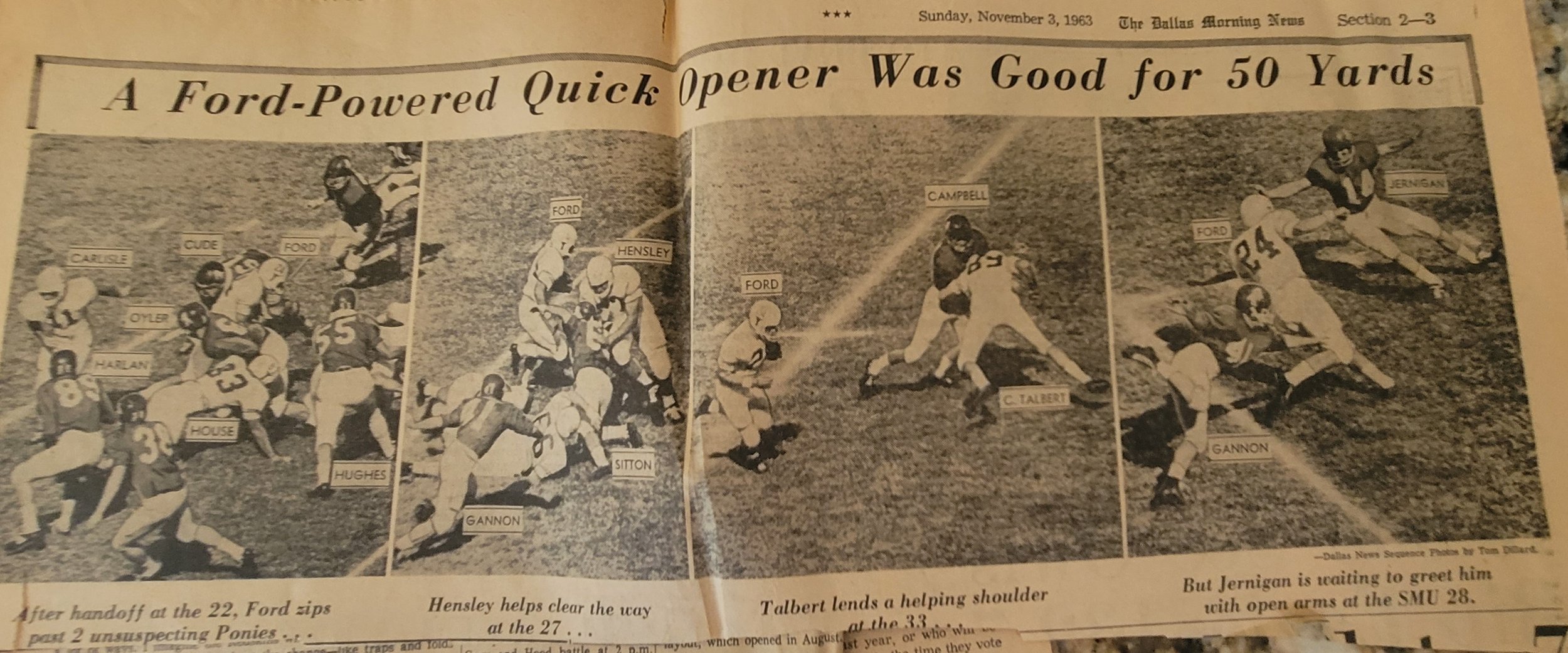




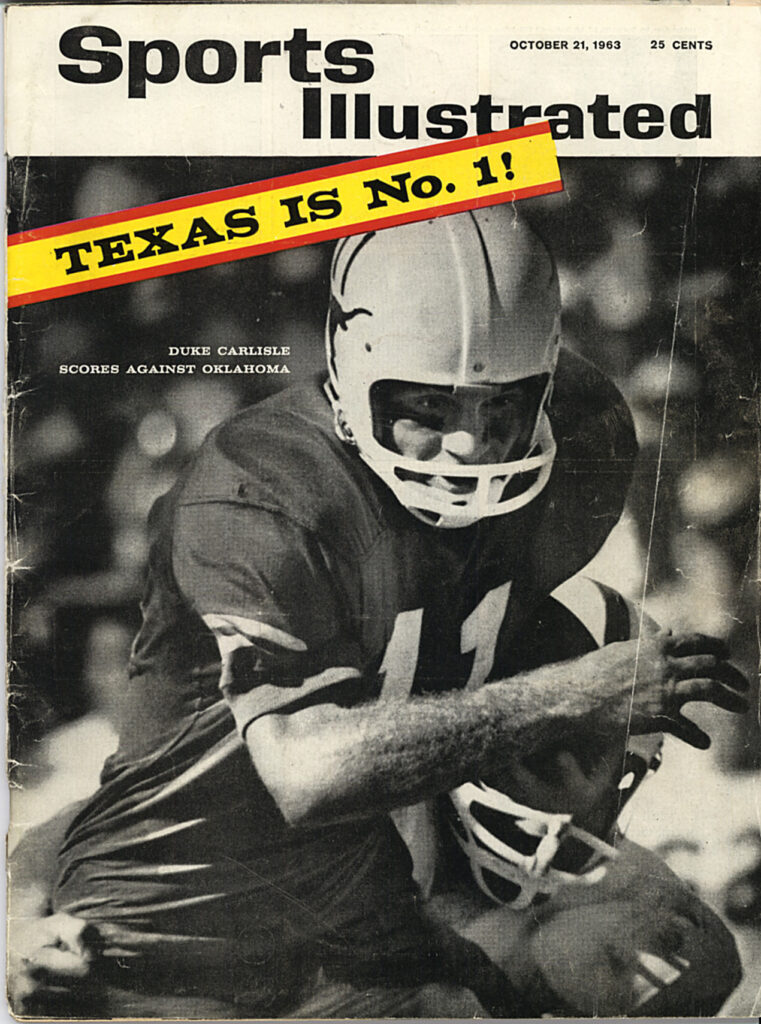
















 MacArthur Bowl was presented to the Texas 1963 National Championship team by General Douglas MacArthur shortly before his death.
MacArthur Bowl was presented to the Texas 1963 National Championship team by General Douglas MacArthur shortly before his death.





